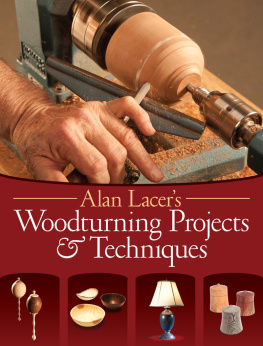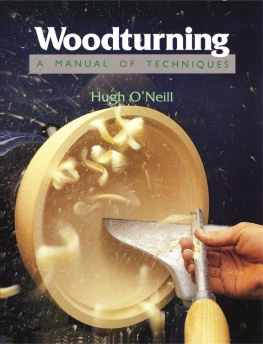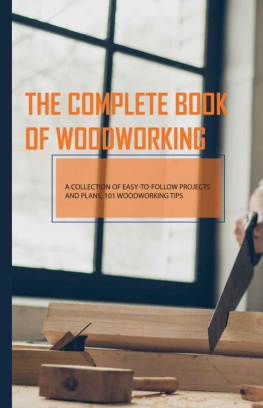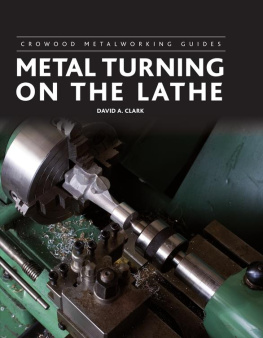Thank you for purchasing this Popular Woodworking eBook.
Sign up for our newsletter and receive special offers, access to free content, and information on the latest new releases and must-have woodworking resources! Plus, receive a coupon code to use on your first purchase from ShopWoodworking.com for signing up.
or visit us online to sign up at
http://popularwoodworking.com/ebook-promo
Dedication
This book is dedicated to my late father, Ray Lacer, a wounded warrior of WWII. He was never quite sure what I did for a living, but was always a huge supporter.
Contents
Foreword
This book is a collection of my writings over a fifteen-year period for American Woodworker Magazine. That work was unusual for me in the sense that the audience generally were not hardcore woodturners, but woodworkers who did furniture, carving, cabinetry and various other aspects of working wood. Certainly there were readers with lathes (actually a large number of them if the surveys were correct) and some were already addicted to this love of mine. However, I always had to keep the readership majority in mind. Projects and techniques I wrote about needed to keep all of this in perspective, but my secret objective was always to tempt the non-turners to try woodturning.
I set out to make specific projects for a range of interests and skill-levels (not only fundamental ones), and I always incorporated a few challenges. Of course, there is the eternal challenge of good design: most of the projects did not require simply duplicating what I made (unlike most furniture projects) but encouraged the reader to make their own interpretation. Funny, because its the natural way of turning that if you tried to do the same form, it is doubtful it would be the same anyway!
Here youll find projects for the furniture maker (legs, a stool, duplication), for the sports person (game calls, fishing lures, bocce ball, baseball bat), around the kitchen (bowls, plates, pepper mills, ice cream scoop handle, butter knife, toothpick holder), for the shop (awl, lathe stand, tool handles, screwdriver handles, shopmade chucks) and more.
And the techniques presented here cover topics for those who have little or no turning experience and even occasionally topics that seasoned turners struggle with such as using a detail gouge, sharpening, skew chisels and so forth. Most of the core tools have specific sections devoted to edge shaping, edge creation and use (bowl gouges, spindle roughing gouge, detail/spindle gouges, skew chisels). There is even a taste of hollow turning (Christmas ornaments and Lowrider boxes) and working larger scale projects (lamp, baseball bat, table legs). Finishing is covered within most projects, but there is also coverage of specific techniques for finishing almost any turned object (oils, shellac, oil/varnish blend and even marbling).
Personally, I benefitted immensely from writing these articles. They were opportunities for me to stay sharp (there are some very critical readers out there who helped keep me honest!), continue to learn, keep developing topics and ideas, strengthen my writing skills and aid me immensely in my teaching pursuits (something that now consumes much of my time as a woodturner).
I encourage you to read this collection of articles and challenge yourself to try some things you have never attempted; you might be pleasantly surprised to find a fresh direction to your turning.


TOOLS & TECHNIQUES
CHAPTER ONE
Bowl Gouges
All you need to turn a gorgeous bowl is one fine tool

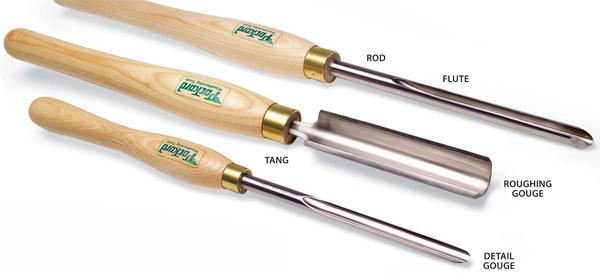
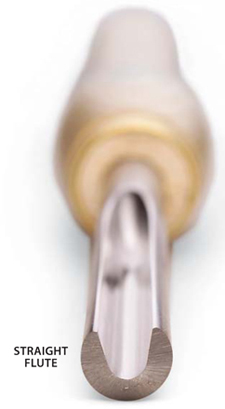
Bowl turning is a blast! Thanks to advances in lathes and tooling, lots of woodworkers have now discovered how fun it is to turn a hunk of green wood into a beautiful bowl. Start to finish, it only takes a few hours, and the wood is usually free.
Whatever the bowls shape, you need one basic tool: a bowl gouge. Ive been asked countless questions about how to buy a bowl gouge during my 25 years as a professional instructor. Theres a lot of confusion about what a bowl gouge really is: how its sized and ground, and which type is best. Heres what you need to know to get started.
What is a Bowl Gouge?
A modern bowl gouge has three parts: a rod, flute and handle. A solid round rod makes the tool very strong. The rods flute is generally a deeply cut oval, which improves the tools chip-cutting action. A bowl gouge usually has a large handle, about 16" long, for increased leverage. A bowl gouge is often confused with a roughing gouge. A roughing gouge is used in spindle work, such as turning a table leg, to remove a blanks square corners or to cut a cylinder or taper. It should not be used for faceplate work, such as turning a bowl. A roughing gouge has a tang, which isnt designed to take as much downward pressure as a rod. The tang could bend or break under the larger force involved in turning a bowl. Bowl gouges are also often confused with detail gouges, which are also called spindle, fingernail or shallow gouges. A detail gouge has a shallower flute than a bowl gouge. A detail gouge is designed for shaping small elements, particularly in spindle work, although it is used in bowl turning for shaping rims, bases and feet.
Flute Shapes
The flute is the inner, milled portion of a bowl gouges rod. The flutes shape varies among manufacturers. Its deep oval may have round or straight sides. Both types are easy to learn how to handle, so it doesnt really matter which one you get. Individual turners have their favorites, but no single design is a runaway winner.
Bowl Gouge Sizing Systems
Manufacturers use two different, competing systems to size bowl gouges, which can be confusing. In the commonly used English system, a gouges size is approximately the width of its flute. In the less commonly used North American system, the gouges size is exactly the diameter of the rod (which I think makes a lot more sense). As a result, the same gouge is usually labeled 18" smaller in the English system than in the North American system. For example, a 12" gouge in the English system is the same size tool as a 58" gouge in the North American system. It's important to note which system a dealer uses before you order.


